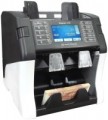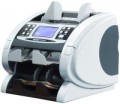Receive pocket capacity
The largest amount of bills or coins that can fit in the counter's receiving pockets. For models with several receiving pockets (for sorting bills/coins), this paragraph usually indicates the total capacity of these pockets. In some devices, it is allowed to install an additional receiving pocket that expands the capacity; capacity of with such a pocket is indicated separately.
It should be taken into account that anyway this parameter is quite approximate, and the actual capacity may differ slightly from the claimed one: bills, even of the same currency, often have different thicknesses, and coins are scattered randomly in the pocket. Nevertheless, according to the claimed capacity, it is quite possible to evaluate different models of counting machines and compare them with each other.
It is worth noting that the receiving pocket often differs in capacity from the loading tray — sometimes up, sometimes down. This moment depends on the features of operating of the counter. So, if the receiving compartment is larger than the loading one, the device can be additionally loaded with a certain amount of money right during the counting, without any possibility of overflowing the receiver. And in the opposite case, when the counter is fully loaded, you will have to unload the receiver right in the process of operation — otherwise it will overflow before the loading tray is empty.
Pocket capacity of rejected bills
The capacity of the pocket for rejected bills provided in the design of the counter. To be more precise, only bills sorters have this feature (see "Product Type"): it is not found in regular counters (both bills and coins).
The pocket for rejected money is a separate compartment, which receive discarded bills are received: counterfeit, heavily worn, dirty, etc. This compartment is considered as a separate function and is not counted of total number of receiving pockets (see “Number of receiving pockets). As for its capacity, it is usually rather small compared to the capacity of the loading and receiving pocket: after all, usually rejected bills make up a very small part of the total stack.
Min. bills size
The smallest bills size that the counter can normally process. Specified by length and width, both of these parameters must be at least the minimum allowable value — otherwise the device will not be able to count properly.
Note that most modern currencies use denominations of more or less standard sizes; and with such popular currencies as the dollar or the euro, any counter is almost guaranteed to be compatible. In addition, the manufacturers of counting machines usually take into account the region where they plan to use them, and the dimensions of local money. So you have to pay attention to the allowable sizes of bills mainly in cases where the counter is planned to be used for less common currencies, the size of which may differ markedly from the average.
Max. bills size
The largest bills size that the counter can normally process. It is specified by length and width, both of these parameters must be less than the maximum allowable value — otherwise the device will not be able to handle with the count.
Note that most modern currencies use denominations of more or less standard sizes; and with such popular currencies as the dollar or the euro, any counter is almost guaranteed to be compatible. In addition, the manufacturers of counting machines usually take into account the region where they plan to use them, and the dimensions of local money. So you have to pay attention to the allowable sizes of bills mainly in cases where the counter is planned to be used for less common currencies, the size of which may differ markedly from the average.
Authenticity Check
Types of authenticity check with certain signs on the money being counted and provided in the design of the counter. Only models for paper money are equipped with detection (see “Product Type”).
—
By size. A detection that involves determining the size of a bills. In bill counters, usually, it is used for sorting by face (see "Functions") or dilapidation, but it can also be used for other purposes — for example, identifying bills that are not related to the currency being counted.
—
By optical density. Detection based on optical density — the ability of a bills to transmit and retain light. It is mainly used to detect sticky bills and prevent counting errors, but can also be used to screen out worn or suspicious bills.
—
By magnetic marks. Detection based on the reading of magnetic marks. Typically, such marks are applied with a special paint, "noticeable" for magnetic sensors; note that they are widely used in US dollars and euros. This type of detection can be used both to determine the denomination and to separate bills in other currencies and detect counterfeit bills.
—
Ultraviolet (UV). Detection using UV radiation. Devices with this feature are able to detect special security elements that are visible only under ultraviolet light, and respond to the absence or non-standard arrangement of s
...uch elements. Due to this, it is possible to detect not only counterfeit or foreign bills, but also money marked with special compositions (for example, bills used as material evidence in a criminal case on a bribe and signed respectively). However, if the possibility of identifying marked bills is fundamentally important for you, its availability should be clarified additionally.
— Infrared (IR). Detection using infrared radiation. By the operating principle, it is similar to the UV detection described above, however, protective IR elements are less common, and their detection is technically more difficult. Therefore, this detection function is found mainly in hi-end devices, in particular, high-precision sorters (see "Product Type").Sorting
Types of bills sorting provided in the device. Sorting itself is found both in specialized note and in coin counters (see "Product Type"). This paragraph is describing the criteria of sorting types which can be processed. However, in devices for coins, only one criterion is used —
by denomination ; so basically this list is relevant for paper money sorters. In such models, in addition, sorting
by face,
by orientation,
by dilapidation and
by date of issue can also occur. Here are the features of each of these options:
— By face. Sorting type that allows you to lay out all the bills face up. With this procedure, bills are divided into two trays, depending on which side they are up; after that, it is enough to take one of the stacks and turn it over as necessary. It should be noted that this function is most often combined with sorting by orientation (see below) — these types of sorting allow you to bring all bills exactly in one position, which is important, for example, before loading into an ATM.
— By orientation. Sorting that allows you to separate bills lying "upside down". Such bills are sent to a separate pocket, after the end of the procedure, it is enough to remove there the entire pack and turn it to the desired orientation. This feature is often combined with the sort by face d
...escribed above, but can be used separately and is generally much more common. This is due to the fact that ordering both by orientation and by face is required relatively rarely — mainly when loading into an ATM and in other similar types of machine money processing; and for convenience, when counting by a person, it is not necessary to place all the bills in exactly the same way — it is enough to deploy them in one orientation.
— By denomination. Sorting of recounted money by denomination. It should be reminded that this is the only type of sorting used not only for bills, but also for coins; specific capabilities of devices with this function may be different. So, the simplest option is to separate bills that do not correspond to some denomination, or that have a denomination more or less a certain value. This operating mode is found only in models for paper money. A more advanced way is sorting by several denominations at once — for example, 1, 5 and 10, or 5, 10 and “greater than 10”. The specific number of simultaneously available denomination options may be different, it can be determined by the number of receiving pockets (see above for more details, but here we recall that in general there are more such pockets in coin devices than in bills sorters).
— Fitness sorting. A feature that allows you to identify bills with obvious signs of dilapidation: old, worn, etc. One of the most popular ways to use this feature is to select money to fill ATMs: such bills should be as new as possible. In addition, sorting by dilapidation can be useful for general purposes — to detect bills of unsatisfactory quality and exchange them for new ones at an authorized banking institution.
— By date of issue. A rather specific feature that is rarely found — mainly in professional-level devices. This is due to the fact that sorting by year of issue is usually not needed in daily work with the cash register, it is used in some special tasks — for example, identifying old (or obsolete) bills for subsequent exchange for new ones.Features
—
Auto start. Counters with this function can automatically start working when money is in the tray. This get rid of turning on the count manually every time, which saves a lot of time and effort — especially when working with a large amount of bills or coins.
—
Value counting. Possibility of summation of the result of several calculations. This feature is especially useful in cases where all the money that needs to be counted cannot be loaded into the device at one time: you can charge small portions, and the total amount of money will be calculated automatically.
—
Batch feature. In this case, packing means the ability to count a strictly defined number of bills/coins from a stack or pile loaded into the counter. This function is designed mainly for cases where bills/coins are to be packed in packs of a certain quantity (hence the name). At the same time, in some devices you can select any number of bills or coins, in others only a few standard options are available (for example, 10, 20, 50 and 100).
—
Serial number scan. Possibility of reading the serial numbers printed on the bills. The specific usage of this feature may vary. So, some devices are able to compare the numbers printed on different parts of the bills; the discrepancy between these numbers indicates that the bill was glued together from sev
...eral parts. More advanced models are able to compare recognized numbers with a special regularly updated database, which contains counterfeit or potentially counterfeit bills (often they can be identified precisely by the serial number). It may also be possible to write all read bills to the memory of the counter or to an external drive such as a USB flash drive — this can be useful for some specific cash handling tasks.Power consumption
The power consumed by the counter in regular operation mode. Usually, the regular mode means the counting process with all additional functions; in standby mode the power consumption is significantly less.
In most cases, this spec is relatively small — even high-end models rarely consume more than 400 watts. Therefore, this parameter has practical importance primarily in specific cases — for example, when calculating the load on a voltage stabilizer or an uninterruptible power supply.

